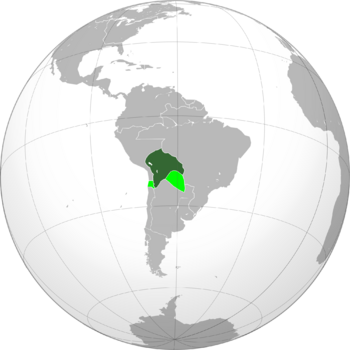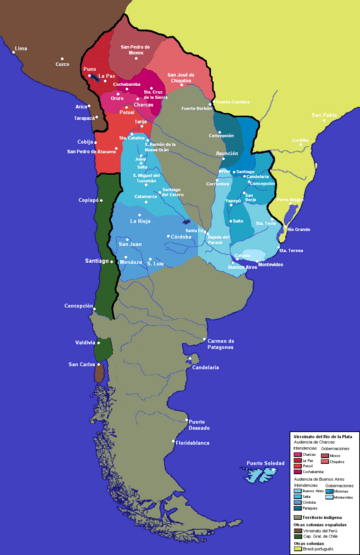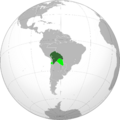Upper Peru facts for kids
Quick facts for kids
Upper Peru
Alto Perú
|
|||||||||
|---|---|---|---|---|---|---|---|---|---|
| 1821–1825 | |||||||||
|
Motto: Plus Ultra
"Further Beyond" |
|||||||||
|
Anthem: Marcha Real
"Royal March (1813–1822; 1823–1873) Himno de Riego "Anthem of Riego" (1822–1823) |
|||||||||

Territories of Alto Peru, 1821–1825
|
|||||||||
| Capital | La Paz | ||||||||
| Common languages | Spanish | ||||||||
| Religion | Roman Catholic | ||||||||
| Government | Absolute monarchy (1821–1825) |
||||||||
| King/Queen | |||||||||
|
• 1821–1825
|
Ferdinand VII | ||||||||
| Viceroy | |||||||||
|
• 1821–1824
|
José de la Serna e Hinojosa | ||||||||
|
• 1824–1825
|
Pío de Tristán | ||||||||
| History | |||||||||
| 28 July 1821 | |||||||||
|
• Independence from Spain as Bolivia
|
6 August 1825 | ||||||||
| Currency | Spanish escudo (1813–1869) Spanish peseta (1869–1873) |
||||||||
|
|||||||||
Upper Peru (Spanish: Alto Perú; Portuguese: Alto Peru) was a region in South America. It was once part of the Spanish Empire. The name "Upper Peru" became common in the late 1700s. This happened after the area, which was ruled by the Real Audiencia of Charcas, moved from the Viceroyalty of Peru to the Viceroyalty of the Río de la Plata in 1776.
Upper Peru included important areas like Potosí, La Paz, Cochabamba, Chiquitos, Moxos, and Charcas (now called Sucre). After a long fight for freedom, known as the Bolivian War of Independence, this region became an independent country. It was then renamed Bolivia to honor the famous leader Simón Bolívar.
Contents
The Fight for Freedom
By 1821, the Spanish rule in Latin America was weakening. This was due to the Napoleonic occupation of Spain. Armies led by generals Simón Bolívar and Antonio José de Sucre were making great progress. They had already helped Venezuela, Colombia, and Ecuador gain their independence. Now, their forces were getting close to the Upper Peru region.
Brazilian Involvement in Upper Peru
In June 1822, leaders from three areas of Upper Peru met in Cuiabá, Brazil. They were worried about the fighting and asked the Brazilian governor for help. They wanted Brazil to take control of their territory. They thought it would be safer to be ruled by a stable monarchy like Brazil. This was better than risking a new, uncertain republic.
The governor of Mato Grosso quickly sent troops into Upper Peru in July 1822. He also closed the borders to stop the freedom fighters from entering. He sent a letter to Prince Regent Pedro I of Brazil, explaining the situation and his actions.
However, Emperor Pedro I received the letter in November 1822. By then, Brazil had already declared its own independence. Brazil was not interested in adding Upper Peru to its territory. The new country was busy dealing with its own internal issues. So, Emperor Pedro I ordered his troops to leave Upper Peru. He stated that Brazil would not get involved in other countries' affairs. This decision cleared the way for the freedom fighters.
Interestingly, Generals Antonio José de Sucre and Simón Bolívar knew what was happening. They sent their own diplomats to Rio de Janeiro very quickly. These diplomats arrived even before the letter from the Mato Grosso governor. This meant that by the time the Emperor received the governor's letter, his mind was already made up. The order to withdraw the troops had already been given.
Colombian Troops Arrive
Between 1823 and 1828, Colombian troops entered and occupied Upper Peru. They were led by Marshal Antonio José de Sucre. This was part of the "Campaigns of the South" to free more parts of South America. The new Republic of Bolivar, formed from Upper Peru, was seen as a close ally of Gran Colombia.
Historical Claims
Over time, both Argentina and Peru made claims to some parts of Upper Peru. They based these claims on historical reasons.
Images for kids
See also
 In Spanish: Alto Perú para niños
In Spanish: Alto Perú para niños





